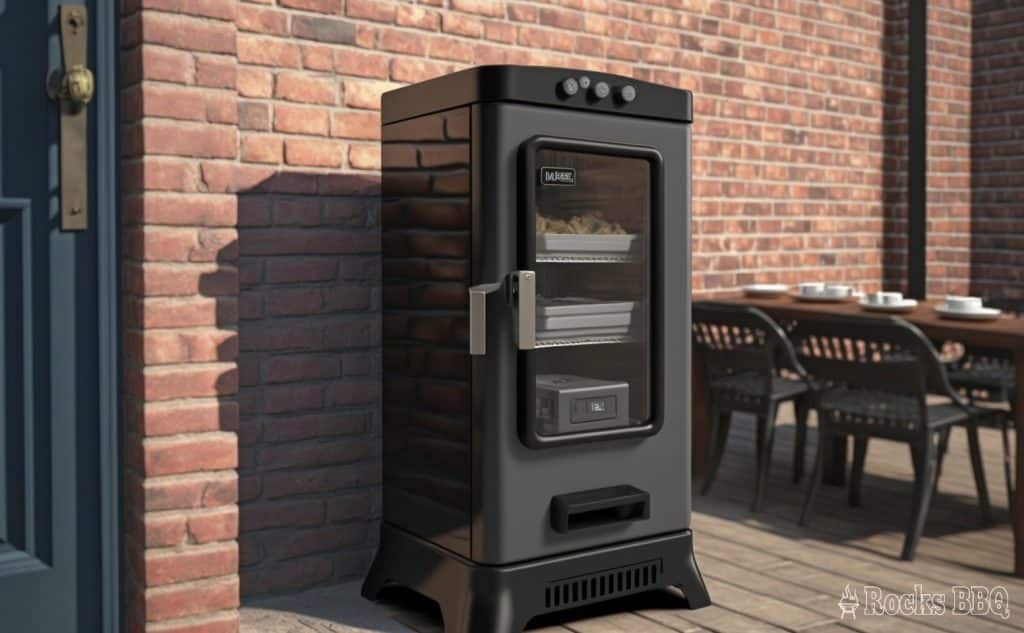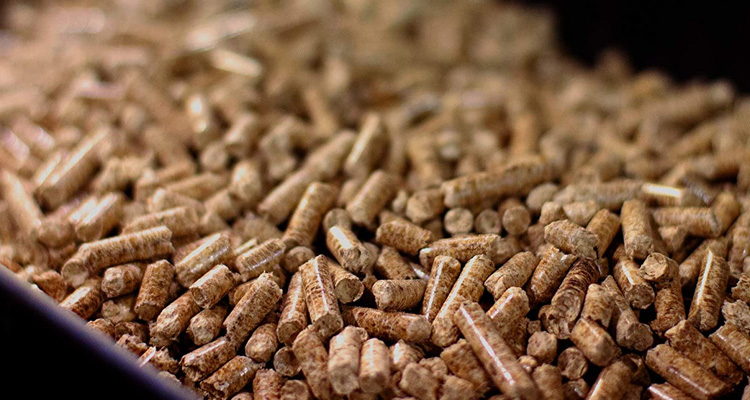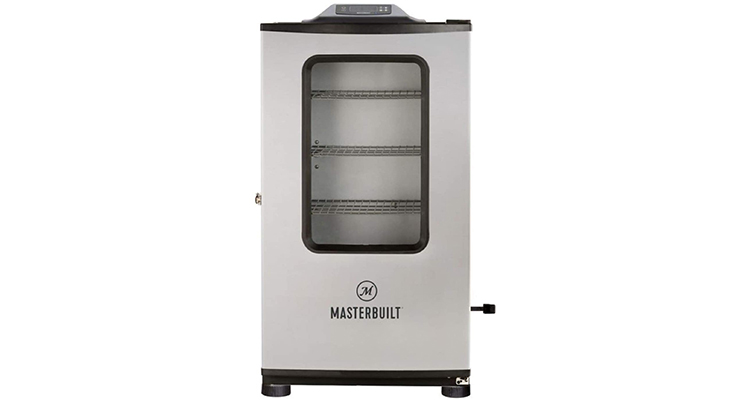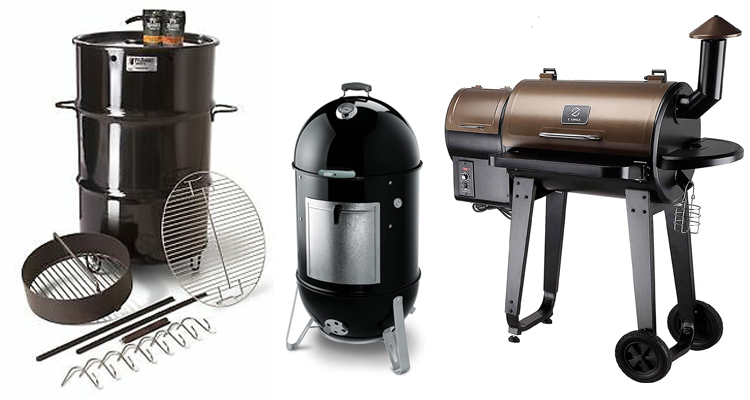
Electric smokers have revolutionized the art of smoking food, making it easier and more convenient for food enthusiasts to enjoy delicious smoked dishes at home.
With precise temperature control, consistent smoke production, and minimal effort, electric smokers have become increasingly popular among both beginners and seasoned barbecue enthusiasts.
In this comprehensive guide, we will explore the ins and outs of electric smokers, their benefits, and how to get the most out of them.
Table of Contents
How Electric Smokers Work

At their core, electric smokers use a heating element to generate the heat required for cooking and smoking food. This heating element, powered by electricity, maintains a consistent temperature throughout the smoking process, ensuring even cooking and optimal flavor.
The smoker’s interior consists of a water pan, a wood chip tray, and a series of cooking racks. The water pan helps maintain the humidity inside the smoker, preventing the food from drying out.
The wood chip tray holds the wood chips, chunks, or pellets that provide the signature smoky flavor. As the heating element warms the wood, it releases smoke that permeates the food on the cooking racks above.
One of the key advantages of most electric smokers is their precise temperature control. Most models have a built-in thermostat or digital control panel that allows users to set and maintain the desired temperature with ease. This feature eliminates the need for constant monitoring and adjustment, making electric smokers an ideal choice for those who prefer a more hands-off approach to smoking food.
Setting Up and Using an Electric Smoker
- Choose a location: Find a level, stable surface for your electric smoker, ideally outdoors or in a well-ventilated area. Keep it away from flammable materials and ensure there’s ample space around the smoker for proper airflow.
- Assemble the smoker: Follow the manufacturer’s instructions to assemble the smoker, ensuring all components are in place, such as the heating element, water pan, wood chip tray, and cooking racks.
- Season the smoker: Before using your electric smoker for the first time, it’s important to season it. This process helps remove any manufacturing residues and creates a protective layer inside the smoker. Heat the smoker to its highest temperature and let it run for about 2-3 hours. Then, let it cool down completely.
- Preheat the smoker: Plug in the smoker and set the desired temperature according to the recipe or type of meat you’re smoking. Allow the smoker to preheat for 30-45 minutes.
- Prepare the water pan: Fill the water pan with water, or a mix of water and other liquids like apple juice or beer for added flavor. The water pan helps maintain humidity inside the smoker, preventing the food from drying out.
- Add wood chips, chunks, or pellets: Load the wood chip tray with your choice of wood chips, chunks, or pellets. Refer to the manufacturer’s guidelines for the recommended amount.
- Place the food on the cooking racks: Arrange the meat or other food items on the cooking racks, leaving enough space between each piece to allow for proper airflow and even cooking.
- Monitor the temperature: Use the built-in thermostat or a separate meat thermometer to monitor the internal temperature of the meat throughout the smoking process.
- Refill wood chips and water as needed: Depending on the duration of your smoke, you may need to add more wood chips or refill the water pan. Check periodically and refill as needed.
- Remove and rest the food: Once the desired internal temperature is reached, carefully remove the food from the smoker and let it rest for 15-20 minutes before slicing or serving.
Wood Chips, Chunks, and Pellets: Making the Right Choice

- Wood Chips: These are small, thin pieces of wood that burn quickly and produce smoke rapidly. They’re ideal for shorter smoking sessions and milder flavors. However, they require more frequent replenishment due to their fast burn rate.
- Wood Chunks: Larger and thicker than wood chips, wood chunks burn slower and produce a more intense, smoky flavor. They’re great for longer smoking sessions but can be harder to ignite, often requiring preheating.
- Pellets: Made from compressed sawdust, wood pellets offer a consistent burn rate and are easy to use. They’re ideal for pellet-specific electric smokers but may not be compatible with all models.
Pros and Cons:
- Wood Chips: Pros – Fast smoke production, suitable for short smokes. Cons – Frequent replenishment, milder flavor.
- Wood Chunks: Pros – Slow, even burn, intense flavor. Cons – Harder to ignite, may require preheating.
- Pellets: Pros – Consistent burn rate, easy to use. Cons – May not be compatible with all smokers, less versatile.
How often to change wood chips:
The frequency of changing wood chips depends on the type of smoker, the temperature, and the duration of the smoking session. Generally, wood chips should be replaced every 1-2 hours, or when they stop producing smoke. Keep an eye on the smoke production and adjust accordingly for the best results.
Tips and Techniques for Perfect Smoked Meat
- Flipping the meat: In most cases, flipping the meat is not necessary when using an electric smoker. The consistent temperature and even heat distribution eliminate the need for turning the meat. However, if you notice uneven cooking, you can flip the meat halfway through the smoking process to ensure even doneness.
- Soaking wood chips: Soaking wood chips in water for 30 minutes to an hour before smoking can prolong their burn time and produce a milder, more consistent smoke. However, some pitmasters argue that soaking wood chips is unnecessary and can result in a longer time to reach the desired temperature due to the evaporation of moisture. Experiment with both soaked and unsoaked chips to find your personal preference.
- Ideal vent position for electric smokers: Proper ventilation is crucial for controlling the amount of smoke inside the smoker and maintaining an even temperature. As a general rule, keep the vent partially open during the smoking process. This allows for adequate airflow and prevents the buildup of creosote, which can create a bitter taste in the food. However, you may need to adjust the vent position based on factors like outdoor temperature and wind conditions.
Common Concerns and Troubleshooting
- Smoke production in electric smokers: Electric smokers are designed to produce a consistent, moderate amount of smoke throughout the cooking process. However, if you find your smoker isn’t producing enough smoke, ensure that the wood chips are dry (if not soaked), the heating element is functioning properly, and there’s enough airflow through the vents.
- Troubleshooting potential issues:
- Uneven cooking: If your food is cooking unevenly, ensure there’s enough space between the pieces for proper airflow. You can also try rotating the cooking racks or flipping the meat if necessary.
- Temperature fluctuations: Ensure the smoker’s door is properly sealed and the vent position is adjusted correctly. Check for any debris or buildup on the heating element that may affect its performance.
- Lack of smoke flavor: Experiment with different types of wood chips, chunks, or pellets to find the best flavor for your preferences. Adjust the amount of wood used and make sure it’s positioned correctly in the smoker.
By addressing these common concerns and applying the right techniques, you can achieve delicious, perfectly smoked meat with your electric smoker.
The Pros and Cons of Electric Smokers

Electric smokers have become increasingly popular among cooking enthusiasts due to their convenience and ease of use. However, like any cooking appliance, they come with their own set of advantages and disadvantages.
Pros:
- Ease of use: Electric smokers are user-friendly and require minimal effort to set up and operate. With adjustable temperature settings, they offer consistent heat for precise cooking.
- Consistent temperature control: Electric smokers maintain a steady temperature throughout the cooking process, ensuring that food is cooked evenly and to the desired level of doneness.
- Safety: Since there is no open flame involved, electric smokers are generally safer than traditional charcoal or gas smokers.
- Indoor use: Electric smokers are suitable for indoor use, making them an ideal choice for those living in apartments or areas with strict outdoor cooking regulations.
- Cleanliness: These smokers produce less mess compared to their charcoal and gas counterparts, as there are no ashes or grease to clean up after cooking.
Cons:
- Limited smoky flavor: Electric smokers may not impart the same rich, smoky flavor as charcoal or wood-fired smokers, which could be a downside for barbecue purists.
- Dependence on electricity: As electric smokers rely on electricity, they cannot be used during power outages or in areas without access to power outlets.
- Slower cooking: Electric smokers may take longer to heat up and cook food compared to charcoal or gas smokers.
- Limited temperature range: Some electric smokers may not reach the high temperatures needed for searing or crisping food.
- Higher initial cost: Electric smokers often have a higher upfront cost than charcoal or gas alternatives, but they may be more cost-effective in the long run due to reduced fuel expenses.
FAQs
Wood chips should be added to an electric smoker every 3-5 hours, depending on the desired level of smokiness and the specific smoker model.
Yes, electric smokers produce smoke using wood chips, which impart flavor to the food being cooked.
Soaking wood chips for 30 minutes to an hour before use in an electric smoker can help prolong the smoldering process and produce more smoke.
Some cons of electric smokers include a limited smoky flavor, dependence on electricity, slower cooking, limited temperature range, and higher initial costs.
No, it is not necessary to flip the meat in an electric smoker, as they provide consistent heat, ensuring even cooking without manual intervention.
Wood chips are recommended for electric smokers, as they burn more easily and produce smoke more consistently than wood chunks.
Wood chips are placed in a designated tray or pan inside the electric smoker, located near the heating element.
While both wood chips and pellets can be used, wood chips are more commonly recommended for electric smokers due to their size and consistency.
Not soaking wood chips can cause them to burn too quickly, producing less smoke and potentially impacting the desired smoky flavor.
Wood chips should be replaced every 3-5 hours, depending on the smoker model and desired level of smokiness.
The vent should generally be open during smoking to allow proper airflow and prevent the buildup of creosote, which can impart a bitter taste to the food.
Conclusion
In conclusion, electric smokers offer a user-friendly and convenient alternative to traditional charcoal and gas smokers. They provide consistent temperature control, safety, and indoor use capabilities, making them an excellent choice for many cooking enthusiasts.
Although they may have some limitations, such as dependence on electricity and a milder smoky flavor, their advantages make them well worth considering. If you’re looking to expand your culinary horizons or simply want a more convenient way to enjoy smoked foods, give electric smokers a try.



